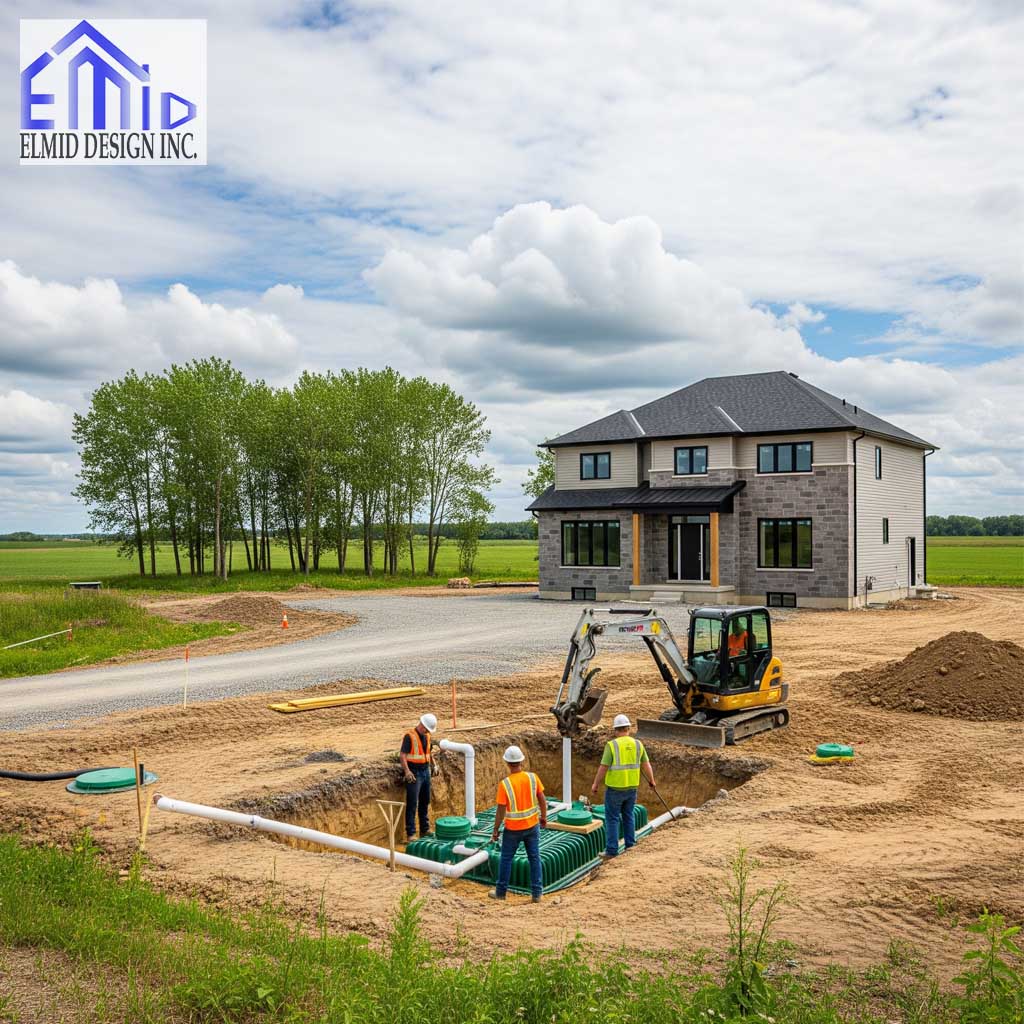In Brampton, proper septic system design is not just a technical necessity—it’s a legal requirement. Whether you’re planning new construction or replacing an outdated system, septic design Brampton services are essential for meeting local building codes and protecting groundwater. Choosing the right designer, understanding the process, and knowing which permits are required will save you both time and money. In this article, you’ll find a practical explanation of everything related to septic design in Brampton, from local rules to engineering firms like Elmid Design Inc. that hold a certificate of authorization from Professional Engineers Ontario (PEO). Keep reading to learn how to make smart choices for your property and avoid the most common septic design mistakes.
Key Takeaways
Septic design in Brampton must follow strict Ontario Building Code rules.
You need a soil evaluation and engineered site plan to get permits.
Hiring a PEO-licensed firm like Elmid Design Inc. ensures compliance.
Design must match the number of bedrooms and lot size.
Advanced systems may be required for difficult soil or space limits.
Working with experienced firms helps reduce permit delays.
Municipal approval is needed before installation can begin.
Understanding Septic Design Requirements in Brampton
The septic design process in Brampton starts with a licensed engineer evaluating soil conditions and local grading. Engineers conduct percolation tests to measure how quickly water drains through the soil. Brampton enforces these steps under Part 8 of the Ontario Building Code. The City’s building department checks every plan to ensure it follows the law. If a property lacks access to municipal sewers, the homeowner must install a properly engineered septic system. This system must treat wastewater safely and prevent contamination of nearby wells or streams. Skipping this process leads to costly delays, fines, or forced redesigns.
Site Evaluation and Soil Testing: The First Step
No septic design in Brampton starts without a thorough site and soil evaluation. This step determines if your property has the right conditions for a traditional septic system. Engineers will dig test pits or boreholes to examine soil type, water table level, and slope. In some cases, soil is too dense or water is too close to the surface. This is where alternative systems come in. Mound systems, tertiary treatment units, and leaching beds are some solutions used when soil fails the standard test. The final soil report is what informs the rest of the septic layout. Without this step, you cannot proceed with a legal installation in Brampton.
Matching Design to Home Size and Usage
Every septic system must match the size and usage of the home it serves. In Brampton, designers calculate system capacity based on the number of bedrooms and fixture units in the house. The design needs to handle peak daily flows, not just average use. Overloading the system leads to early failure and pollution. This is why professional firms like Elmid Design Inc. base their designs on actual water usage data and future expansion plans. Systems for three-bedroom homes will differ from those designed for five-bedroom homes or homes with secondary units. Brampton’s building department checks these calculations before granting any approval.
Choosing the Right Type of Septic System
There is no one-size-fits-all when it comes to septic design in Brampton. Most properties will either use a conventional gravity-fed system or a pump-based system, depending on topography. For poor soils or small lots, advanced systems like aerobic treatment units or sand filters may be required. The design has to balance function, cost, and long-term maintenance. Engineers will also consider frost depth, access for pumping, and environmental sensitivity. In flood-prone areas or properties near water bodies, enhanced treatment standards might apply. Brampton’s inspectors will reject designs that fail to consider these local variables.
Getting Municipal Permits for Septic Installation
Before installation can begin, you must submit a complete application package to the City of Brampton. This includes the septic design drawings, site plan, soil test results, and construction details. Only a PEO-certified engineer can sign off on this application. The city’s building department then reviews the package to ensure the system meets the Ontario Building Code. If any part of the submission is incomplete or inaccurate, the review process can stall. Hiring experienced professionals like Elmid Design Inc. helps avoid delays, because they understand what Brampton’s officials expect. Once approved, you’ll receive a permit that allows construction to start legally.
Why Work With PEO-Licensed Firms Like Elmid Design Inc.
Only licensed professionals should handle septic design in Brampton. Unlicensed designers often guess or cut corners, which leads to rejected plans and costly rework. Elmid Design Inc. operates as a PEO-authorized engineering firm, meeting strict standards for safety, quality, and legal compliance. Their engineers use advanced design tools, follow ethical guidelines, and maintain full insurance. Homeowners in Brampton trust firms like this to avoid permit delays and legal problems. Many who choose unlicensed plans end up paying double to fix avoidable mistakes. Working with a certified expert from the start protects your time, money, and property.
Common Septic Design Challenges in Brampton
Some properties in Brampton are difficult to design for. Challenges include high water tables, shallow bedrock, small lot sizes, and proximity to water sources. Infill lots, where homes are added to existing neighborhoods, often lack space for traditional systems. Other times, trees or underground utilities get in the way. Experienced designers use advanced methods like contour maps and CAD software to find workable layouts. They may recommend split leaching beds or pressurized dosing systems to overcome slope or soil limitations. Being creative within code limits is what separates expert engineers from basic draftsmen.
Advanced Treatment Technologies for Difficult Lots
When conventional septic systems won’t work, advanced treatment technologies are the answer. These include aerobic treatment units (ATUs), sand filter systems, peat biofilters, and constructed wetlands. Each has different maintenance needs and upfront costs. In Brampton, using these systems often requires additional documentation and inspection. That’s because they’re considered alternative solutions under the Ontario Building Code. They treat wastewater more efficiently but must be maintained with care. Engineers at Elmid Design Inc. have experience with these systems and can guide clients on long-term costs. Choosing the right technology is about more than just passing the inspection—it’s about performance over time.
Importance of a Grading Plan in Septic Design
A septic system doesn’t work well if the grading of the land causes runoff to pool near the tank or leaching bed. Brampton’s inspectors often request a grading plan alongside the septic design. This plan shows how surface water will drain away from the house and the system. Poor drainage leads to premature system failure. Engineers design the site so that slope, swales, and surface materials all work together. In high clay soil areas, this is even more critical. Grading plans protect both your home and the environment by reducing contamination risk.
Timeline and Cost Expectations for Homeowners
Most septic design projects in Brampton take two to four weeks to complete from start to permit submission. Construction usually takes another one to two weeks, depending on weather and contractor availability. Costs vary widely but start around $5,000 and can go up to $25,000 for advanced systems. Site conditions, tank size, and permit fees all affect the final price. Elmid Design Inc. provides itemized quotes that help you understand exactly what you’re paying for. Avoid designers who offer vague or verbal estimates. With septic design, transparency saves you from costly surprises later.

Inspections During and After Septic Installation
Once construction begins, inspections are a mandatory part of the septic design process in Brampton. The City of Brampton requires multiple site visits to verify that installation matches approved plans. These inspections occur before the system is buried, ensuring tanks and pipes are set correctly and meet slope requirements. If inspectors find deviations, work must pause until corrections are made. Skipping these inspections can lead to stop-work orders, costly removals, and reinstallation. Working with a firm like Elmid Design Inc. ensures inspections are anticipated and planned, reducing downtime and avoiding fines. Their engineered plans always include compliance details aligned with Brampton codes.
Long-Term Maintenance After Approval
Owning a septic system involves more than just installation. In Brampton, homeowners are legally responsible for ongoing maintenance. This means pumping tanks regularly, inspecting leaching beds for signs of failure, and keeping records for future sale or inspection. While the system design might be perfect, neglecting upkeep can cause backups, contamination, or complete failure. Advanced systems may also include mechanical parts that need service. Engineers at Elmid Design Inc. often include maintenance guidelines with their design packages, offering clarity and helping homeowners stay compliant. Consistent care preserves the lifespan of your system and protects local water supplies.
Legal Liability for Improper Septic Systems
Improperly designed or maintained septic systems carry serious legal risks. If a system fails and contaminates nearby wells, creeks, or municipal water, homeowners face fines, lawsuits, and environmental cleanup costs. Brampton’s building codes are strict for this reason. Even if a contractor builds the system, legal responsibility ultimately stays with the property owner. This is why choosing a PEO-certified engineering firm like Elmid Design Inc. is essential. Their licensed engineers carry liability insurance and follow strict design standards. This reduces the chance of failure and protects homeowners from costly legal exposure linked to environmental harm or health risks.
Septic Design in Subdivisions and New Developments
In new developments on the outskirts of Brampton, septic systems are often the only solution before municipal sewer extensions occur. These areas require coordinated designs for multiple lots. Engineers must consider spacing between systems, shared drainage, and environmental buffers. Designs must not only meet current use but also plan for growth. Elmid Design Inc. is experienced with subdivision-level planning, helping developers navigate zoning rules and regional approvals. They create scalable solutions that prevent overloading and future compliance issues. In fast-growing areas of Brampton, planning for septic systems at this level can accelerate development and avoid costly redesigns later.
Why Septic Designs Get Rejected in Brampton
Permit applications in Brampton often get delayed or denied due to common mistakes. Incomplete soil reports, incorrect site plans, or missing calculations are the top reasons for rejection. Other times, the design fails to meet Ontario Building Code standards or does not fit the property’s terrain. These mistakes typically occur when unlicensed designers or contractors attempt to submit plans without full engineering knowledge. Brampton officials look for professional accuracy, not guesswork. Elmid Design Inc. ensures all documents are complete, signed by PEO-licensed engineers, and ready for fast approval. This professional touch saves applicants from the stress and cost of repeated submissions.
How Septic Design Protects Groundwater and Environment
Proper septic design in Brampton is more than just a technical requirement. It is a safeguard for the environment and public health. Septic systems treat household wastewater and release it into the soil. If designed poorly, harmful bacteria, nitrates, and chemicals can seep into groundwater. This puts wells, streams, and lakes at risk. A good design ensures the effluent is filtered properly and doesn’t pool or overflow. Engineers calculate setbacks from water sources, and advanced systems further treat waste when basic soil filtration is not enough. Firms like Elmid Design Inc. focus on long-term safety, balancing environmental health with engineering precision.
Professional Reports Required for Permits
The septic permit application in Brampton requires more than a sketch. Applicants must submit engineered design drawings, site grading plans, percolation test results, and a summary report. This report explains how the system was chosen, how it meets code, and why it fits the site. Without this report, most applications will be delayed or rejected. The City of Brampton expects professional documentation, especially in areas near protected lands or drinking water zones. Elmid Design Inc. provides full documentation tailored to meet these expectations. Their engineers understand local requirements and present them in a clear, organized format that accelerates the approval process.
What Happens During a System Failure
Septic system failure in Brampton usually starts with slow drains, foul odors, or standing water near the leaching bed. These warning signs create health hazards and damage property if ignored. When a system fails, the City of Brampton often requires soil restoration before issuing a permit for a new system. Licensed engineers must assess the issue, identify the cause, and design a compliant replacement. Elmid Design Inc. performs on-site evaluations and forensic reviews to uncover the exact failure point. Their engineers then prepare a new plan that improves reliability. Most failures result from outdated systems, overuse, or neglected maintenance—not random chance.
Role of Technology in Modern Septic Design
Modern septic design relies heavily on digital tools and data analysis. In Brampton, engineers use CAD software to produce accurate plans and GIS mapping for site evaluation. Some firms also integrate real-time data from environmental sensors and soil probes. This allows for more precise designs that adapt to complex terrains. Elmid Design Inc. uses 3D modeling and topographical data to optimize layouts and prevent runoff issues. These tools help reduce waste, lower construction errors, and speed up inspections. The role of technology ensures every design meets today’s standards while preparing for tomorrow’s environmental challenges.
Frequently Asked Questions
How much does septic design cost in Brampton?
The typical cost for septic design in Brampton ranges between $2,500 and $5,000 depending on property size and complexity. This does not include construction, which can add $5,000 to $20,000 based on system type and soil conditions.
Can I install my own septic system in Brampton?
You may hire your own contractor for installation, but the system must be designed by a licensed engineer and approved by Brampton’s building department. Self-installation without approved design is illegal.
How long does it take to get a septic permit in Brampton?
Most permits take two to four weeks to process if all documents are correct. Delays happen when applications lack required reports or drawings. Hiring experienced engineers speeds up this process.
What if my soil fails the percolation test?
If the soil fails, you’ll need an alternative system like a mound or an aerobic treatment unit. These systems require extra approvals but are often the only option for poor soils.
Who is responsible for septic system maintenance?
The homeowner is responsible for regular inspections, pumping, and repairs. If the system fails, the owner must fix it or face fines and legal penalties.

Why Elmid Design Inc. Is Brampton’s Trusted Name in Septic Design
Elmid Design Inc. is a Professional Engineers Ontario (PEO) licensed engineering firm offering expert septic design Brampton services tailored for residential and commercial projects. With a Certificate of Authorization, we deliver permit-ready plans, accurate soil evaluations, and detailed site grading designs. Our engineers ensure every system meets Ontario Building Code Part 8 while protecting groundwater and local ecosystems. Backed by advanced tools and years of local experience, Elmid Design Inc. streamlines approvals and safeguards your investment with reliable, compliant solutions trusted across the GTA.
Geographic Locations That We Service:
Our Licensed Professional Engineers specializing in Engineered Site Grading Plans offer the best-engineered site grading plan, lot grading and erosion plan, and drainage plan to obtain site plan approval and building permits in Ontario, including a wide range of municipalities. Each area boasts unique features and requirements, making our tailored approach essential for success.
Toronto and Surrounding Areas
In the vibrant heart of Ontario, we service Toronto (City of Toronto) and surrounding areas. Additionally, we cover Oshawa (City of Oshawa), Pickering (City of Pickering), and Clarington (Municipality of Clarington). Furthermore, our expertise extends to Ajax (Town of Ajax), Whitby (Town of Whitby), Brock (Township of Brock), Scugog (Township of Scugog), and Uxbridge (Township of Uxbridge).
Halton Region
Moving to the Halton Region, our services encompass Burlington (City of Burlington) and Halton Hills (Town of Halton Hills). Also included are Milton (Town of Milton) and Oakville (Town of Oakville).
Peel Region
In the Peel Region, we provide services in Brampton (City of Brampton), Mississauga (City of Mississauga), and Caledon (Town of Caledon).
York Region
Our services in the York Region cover Vaughan (City of Vaughan), Aurora (Town of Aurora), and East Gwillimbury (Town of East Gwillimbury). We also cater to Georgina (Town of Georgina), Markham (City of Markham), Newmarket (Town of Newmarket), Richmond Hill (City of Richmond Hill), Whitchurch-Stouffville (Town of Whitchurch-Stouffville), King (Township of King), and Bradford-West Gwillimbury (Town of Bradford-West Gwillimbury). Each municipality here offers a distinct setting, requiring our specialized approach.
Other Southern Ontario Cities and Towns
We also serve many other cities and towns in Southern Ontario. These include Hamilton (City of Hamilton), St. Catharines (City of St. Catharines), Niagara on the Lake (Town of Niagara on the Lake), Brant (County of Brant), Cambridge (City of Cambridge), Kitchener (City of Kitchener), Waterloo (City of Waterloo), and Woodstock (City of Woodstock). Furthermore, we operate in Guelph (City of Guelph), Centre Wellington (Township of Centre Wellington), Shelburne (Town of Shelburne), Orangeville (Town of Orangeville), New Tecumseth (Town of New Tecumseth), Essa (Town of Essa), Collingwood (Town of Collingwood), Wasaga Beach (Town of Wasaga Beach), Barrie (City of Barrie), Midland (Town of Midland), Orillia (City of Orillia), Ramara (Town of Ramara), Minden Hills (Town of Minden Hills), North Kawartha (Town of North Kawartha), Kawartha Lakes (City of Kawartha Lakes), Peterborough (City of Peterborough), Selwyn (Town of Selwyn), and Brighton (Municipality of Brighton).Contact us




